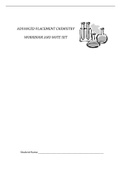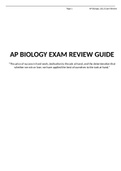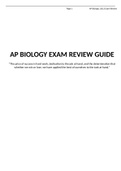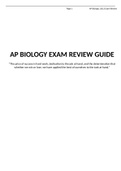BIOL 1406
Temple College
All 4 résultats
Trier par

-
ADVANCED PLACEMENT CHEMISTRY WORKBOOK AND NOTE SET Student Name ______________________________________________________________ ADVANCED PLACEMENT CHEMISTRY WORKBOOK AND NOTE SET
- Notes de cours • 287 pages • 2022
-
- 10,10 €
- + en savoir plus
Fundamental Review 2 Atomic Character and Structure 2 Atomic Number 2 Mass Number and Isotopes 3 Ions and Electrical Charge 5 Molecules and Molecular Compounds; Ions and Ionic Compounds 6 Quantitative Aspects of Compounds 7 Percentage Composition 7 Empirical and Molecular Formulas 7 Hydrated Compounds and their Formulas 10 Mass Ratios 11 Stoichiometry Review 12 Limiting Reactants 12 Theoretical and Percent Yield 13 Percent Error 14 Review of the Periodic Table 15 Oxidation Number...

-
BIOL 1406AP Biology Exam Review
- Examen • 62 pages • 2022
-
- 8,65 €
- + en savoir plus
1. CHNOPS- most common elements in all living matter 2. Bonds- ionic (transfer electrons), covalent (sharing- polar/unequal sharing and non-polar/equal sharing), hydrogen (weak bonds between hydrogen and negatively charged items), hydrophobic interactions (how non-polar compounds congregate together- lipids) 3. pH a. acid-base/ 0-14, # of H ions determines scale; logarithmic- pH 3 = 10-3 = 1/1000 b. blood- 7.4, stomach- 2, small intestine- 8; enzymes are specific to pH 4. Water properties...
AP BIOLOGY EXAM REVIEW GUIDE

-
AP Biology Exam Review-Key
- Examen • 62 pages • 2022
-
- 9,13 €
- + en savoir plus
CONCEPT 1 - BIOCHEMISTRY 1. CHNOPS- most common elements in all living matter 2. Bonds- ionic (transfer electrons), covalent (sharing- polar/unequal sharing and non-polar/equal sharing), hydrogen (weak bonds between hydrogen and negatively charged items), hydrophobic interactions (how non-polar compounds congregate together- lipids) 3. pH a. acid-base/ 0-14, # of H ions determines scale; logarithmic- pH 3 = 10-3 = 1/1000 b. blood- 7.4, stomach- 2, small intestine- 8; enzymes are specific ...

Ce résumé que vous venez d'acheter a fait très plaisir à quelqu'un. Vous voulez aussi être payé chaque semaine ? Vendez vos documents d'étude sur Stuvia ! Découvrez tout sur gagner de l'argent sur Stuvia



